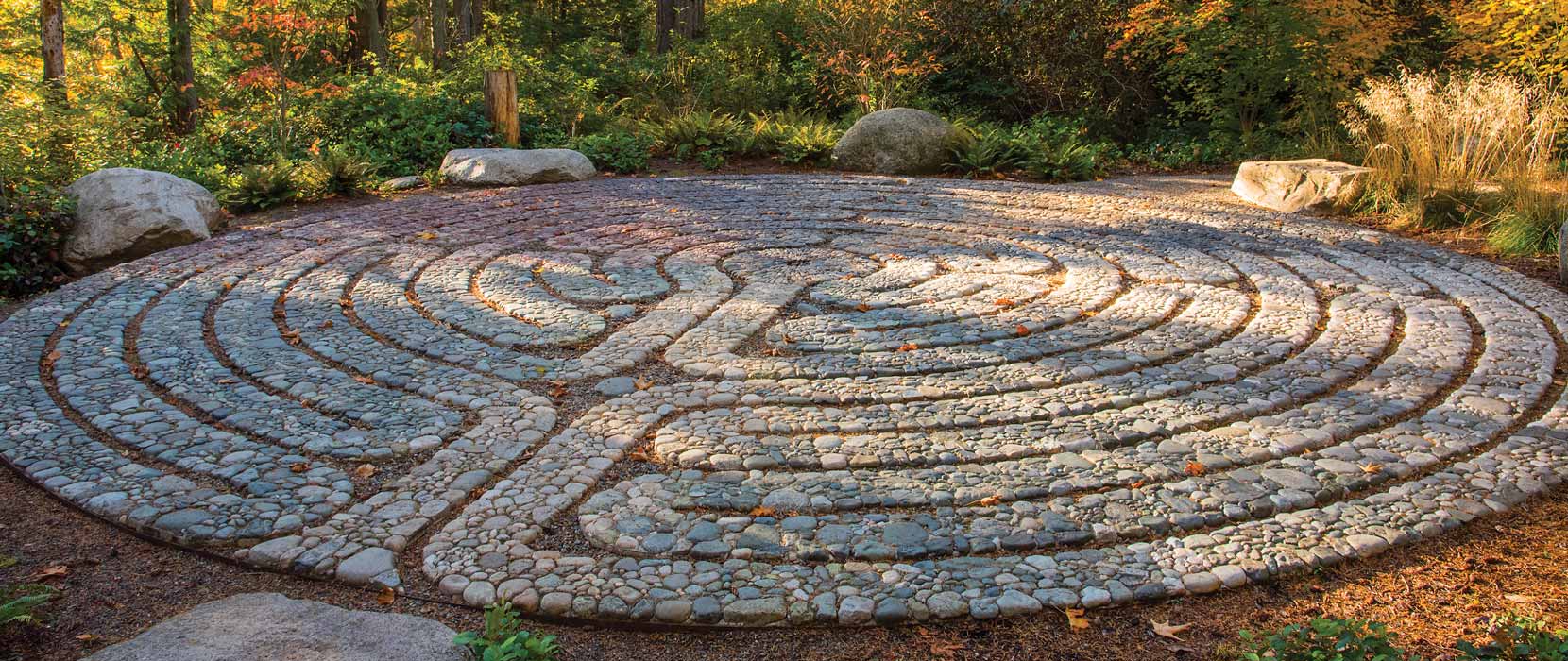Summer 2022
At the Center is Joy
The labyrinth led somewhere surprising
- Story by Anita Thomas

Photo by Warren Lynn
I HAVE REGULARLY engaged in the spiritual practice of walking a labyrinth. A place and a practice that centers and grounds me. I enjoy the sensory experiences: the crinkle of grass collapsing under my feet, the sweet smell of flowers and trees, and the delightful warmth of the sunlight. If birds are chirping, I sometimes find myself humming, and truth be told, I often sing. Usually some form of gospel music.
I find that when I am faced with a dilemma, need to make a decision about some new direction, or when I want to recenter on wellness or start a new season, I’m drawn back to walking the labyrinth, to the attentiveness it inspires.
THERE ARE A VARIETY of labyrinths, associated with ancient times and religious orders, with the intention of connecting one’s spirit to the earth and to God, a way to find balance, peace, and engage in mindfulness. A labyrinth path, which differs from a maze, is an intentional path that moves from the outside in a single path to the center.
There are two contemplative approaches to a labyrinth. The first, apophatic, is open-ended, a stance of internal listening to emotions, thoughts, and sensations that potentially arise without engaging in judgment. The second, kataphatic, has the same sense of openness, with the structured reflection on a situation, question, challenge, or relationship. The idea is that you start walking the labyrinth while contemplating the question at hand and notice where you arrive in decision-making. The difference in the approaches lies in the intent. One walk engages in open discovery; the other aims for directed contemplation.
At the university where I work, we have an indoor labyrinth. I usually enter with an apophatic frame, clearing my mind to simply enjoy the experience and allow myself to be connected to the spirit. That said, the COVID-19 period has made it particularly difficult to clear my mind and enter a space without judgment.
THESE PAST COUPLE of years have certainly been for me a time of struggle. In addition to the pandemic, we have experienced the ugliness of racial injustice, the heartache of economic insecurity, and the pain of civil unrest. Time perspective has shifted, as 2020 and 2021 felt like one elongated year. I had Zoom fatigue, I missed visiting with my family and friends in person, and I gave up on separating work and family life. I have found it challenging to stay strong.
One winter day during this period of struggle, I decided to walk our indoor labyrinth. It was a particularly bright and sunny day in the winter wonderland of Minnesota. I decided to walk in my tights to enhance the tactile sensation of walking and to listen for the sounds on the mat.
Then the strangest feelings came over me. I found myself needing to concentrate on the walking more than usual because a small giggle began to emerge. I had never laughed while walking a labyrinth, but the closer to the center I came, the more the giggles increased, until I was laughing in hysterics. When I reached the center, I felt an incredible amount of joy and peace and began to cry with joy, all while still laughing. I was the only one on the floor at the time, and the idea of someone walking past and looking at the chief academic officer erupting in laughter in a room all by herself led me to laugh even harder. Then these words came to me “Rejoice in the Lord always, rejoice!” These words became the repetitive mantra for my journey out of the labyrinth.
I journaled on the experience because it was such an unusual reaction. I was amazed that the feeling of joy and the freedom of laughter were so intense for me. I couldn’t remember the last time that I had felt so much joy, certainly well before the pandemic, and well before the murder of George Floyd. I recognized that this period felt like a spiritual crisis for me. My values and commitment to Catholic social teaching were constantly being called into question: How did we allow the COVID-19 global pandemic to become a political concern? If we all are working to preserve the life and dignity of each human person, how could we not take actions to protect us all, and especially the least of these, the elderly and children? Why would we continue to allow police brutality to take the lives of individuals? How was I working to build community when I felt and saw fractures and divisions seemingly everywhere, even in my institution? Why were our systems—health, economic, education, political—failing to protect? How were we going to engage in anti-racist work to uproot the racism deeply embedded in our systems? Was the church working as a collective? Couldn’t we respect rights that promote an economy that protects human life, defends human rights, and advances the well-being of all?
Wrestling with those questions in the journal made me laugh out loud again. Again, a surprising reaction to such difficult questions. But I realized that somehow, the burden of the world had become mine. Somehow I had taken on the worry and pain of the redeemer. And somehow, I’d lost the centrality of joy in my life.
The labyrinth in the sunlight had truly led me to my center. I had emerged from the experience refreshed and renewed, with the desire to keep giggling and keep my joy intact.
ANITA JONES THOMAS, PHD, is the executive vice president and provost at St. Catherine University. She holds a doctorate in counseling psychology from Loyola University Chicago, specializing in family therapy and multicultural counseling. Thomas has conducted seminars and workshops on multicultural issues for state and national professional organizations in counseling and psychology, hospitals and corporations, and human service organizations.